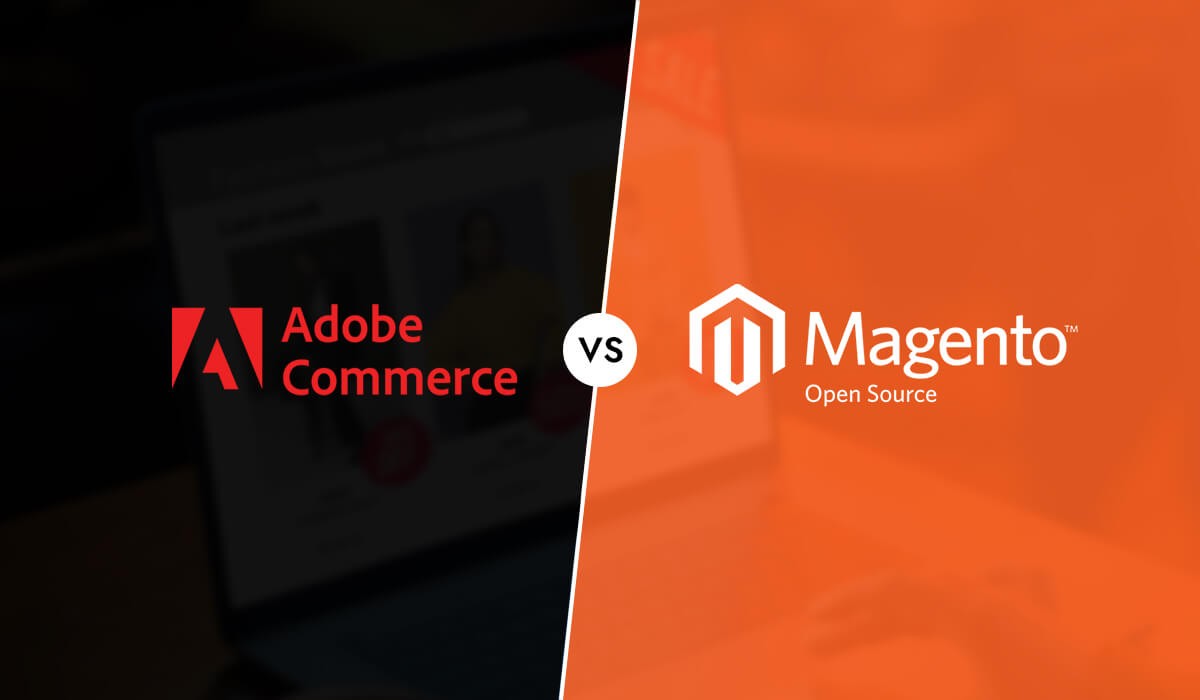Magento, one of the most popular e-commerce platforms in the world, has been around for more than a decade now. Ever since its public introduction on March 31, 2008, many small businesses have relied on it for building their e-commerce websites.
Now, in a country like Germany, e-commerce is a significant part of the retail landscape. Naturally, it comes as no surprise that Magento is the most popular platform in German e-commerce, with about 19% of online shops using it. However, to make the most of Magento’s capabilities, a thorough understanding of its various versions is crucial.
Currently, there are two main versions of the e-commerce website platform:
-
The free Magento Open Source
-
The paid Magento Commerce or Adobe Commerce
Other than that, there is also the managed hosting platform, Magento Commerce Cloud Edition. Adobe even introduced a bunch of upgrades to Magento 2 after acquiring Magento in 2018.
Magento 2 Open-Source vs Magento Commerce: A Quick Overview
Sure, Magento Open Source and Magento 2 Commerce are variations of the same product. But there are ample differences between the two. Apart from being free to use, Magento Open Source offers easy customisation as per your business requirements.
The enterprise edition, Magento Commerce, on the other hand, offers much more varied features and functionality for users. However, both require the help of a certified practitioner to implement these modifications to accommodate your visions in your store.
Here is a detailed analysis of the differences between Magento 2 Open Source and Magento Commerce to help you decide.
Adobe Commerce vs Magento Open Source: Key Features
When comparing Adobe Commerce and Magento Open Source, you must understand that they have some overlapping features. For instance, a highly responsive website experience, simple checkout and payment options are some of the trademarks of all Magento products.
Another interesting thing is that Open Source continues to retain its original name, while the paid version was changed to Adobe Commerce.
However, the company continues to provide its free version to users despite Adobe Commerce, the premium, paid version of Magento, being available. In a country like Germany, where there are almost 2.6 million small and medium-sized businesses (SMBs), this is immensely helpful.
Note: Germany (Deutschland) was among the three European countries with the highest e-commerce penetration in 2020.
The Open Source Edition continues to cater to a wider need of small business owners, while the Commerce Edition platform is useful to larger enterprises. Moreover, there are ample resources available to help you maximise Adobe Commerce, Magento Open Source, and other Adobe services.
Magento Open Source
The Open Source version of Magento provides a comprehensive solution for your online commerce store. These features are not only time and cost-effective but also help you improve your services.
For instance, the platform comes with some ready-to-use and highly scalable features that are excellent for improving the online experience of your shoppers. Additionally, store owners will not have to worry much about the admin work for their business needs.
The license-fee-free edition of Magento offers a highly organised setup, filled with lots of templates and third-party extensions. You can easily access these via Magento Marketplace. Let's dive into the features of the platform in detail.
-
Advanced Payment Modules: Magento 2 Open Source is integrated with Klarna Checkout to offer ease of payment on your e-commerce store. By teaming up with Klarna, one of the largest banks in Europe, Magento helps over 250,000 merchants across 17 countries, including Germany (Deutschland).
-
API: Magento Open Source 2 has an API framework that supports all kinds of web services. This makes sharing data across the platform easier. For example, you can better organise and manage your product catalogue with a catalogue API. You can also improve the scalability and speed of your e-commerce web application with an efficient service endpoint. As a result, your store becomes more mobile-friendly, and shopping becomes more effortless.
-
Drag & Drop Page Builder: With the integration with Page Builder and BlueFoot CMS, Magento 2 Open Source provides the drag-and-drop feature. It allows building new website pages without having prior coding knowledge.
-
ElasticSearch and OpenSearch: These are highly useful features of Magento 2 Open Source that ensure a faster search on the platform. Searching on the Magento 2 Open Source ecosystem becomes even more functional with OpenSearch, an open-source derivative of Elasticsearch 7.10.2. These highly customisable search engines also offer multi-language support, real-time indexing, and an overall better shopping experience for your customers.
-
Magento Catalogue Management: The huge number of features that come with Magento 2 Open Source allow better product catalogue management. This makes updating your catalogues, whenever updating an existing product or adding new ones on your e-commerce site, a lot easier.
-
Magento PWA Studio: The Magento Progressive Web Applications (PWA) is an efficient feature for creating reliable and installable web applications for e-commerce stores. With its help, businesses can get an app-like vibe in terms of the design and features of their online shops. Moreover, it enables working with low internet speed and even offline without disrupting the loading time.
-
Security Features: Security is a vital aspect of running any online business. Magento Open Source takes care of this for you with one of the most robust security features for e-commerce. The platform regularly checks for vulnerabilities, with the Magento Security Centre releasing new security patches and updates every now and then.
-
Two-Factor Authentication: Magento 2 Open Source not only ensures more convenience while shopping, but also enhances customer security. The two-factor authentication (2FA) allows your users to validate their identity and prevent potential threats arising from data sniffing, keyloggers, and unsecured networks. Users can validate through an OTP sent to them via email, text, or phone call. This way it helps create an IP whitelist, making your customer's device the key to their access to their account.
Adobe Commerce
Magento Commerce or Adobe Commerce - the paid version of Magento comes with many features similar to the Magento Open Source Edition. This might make you wonder why you should go for the paid version at all when the free open-source version is available.
Truth is, the open-source version lacks many advanced features, which are available only with Magento Commerce.
For instance, Magento Open Source does not have any B2B functionality. So, store owners must get additional extensions installed to optimise their sites.
Apart from this, the paid version also provides you with analytics, indexing, and advanced reporting features powered by Magento Business Intelligence. All these are lacking in the open-source version. But they are useful for extending your store capabilities using a single resource.
So, merchants who need a robust e-commerce solution would be better off with Magento Commerce. Let's look at some of its features to understand this fact in detail.
-
Adobe Commerce Intelligence: Adobe Commerce single-handedly allows you to create reports and optimise your e-commerce business with the data-driven AI, Adobe Commerce Intelligence (previously known as Magento Business Intelligence). Although a cloud-based data management tool, it is also available in the Adobe Commerce On-premise Base Package. This feature helps manage all your e-commerce data and check factors like business health, average order value, customer lifetime value, and retention rates.
-
Advanced Segmentation: Customer segmentation is crucial for brands to personalise their marketing approach. The Segmentation IQ feature on Magento Commerce saves countless hours of going through organisation metrics to find relevant differences between segments. Thanks to this feature, you will have no trouble personalising customer attributes and product displays for your customers.
-
Headless Commerce (PWA Studio): One of the best features of the commerce edition of Magento is its headless API-based structure. As a store owner, it gives you unmatched flexibility in modifying the front-end part of the website as it is separated from its back-end. So you can easily create individual user experiences across various devices.
-
Inventory and Order Management: The inventory and order management feature of Magento Commerce (Adobe Commerce) helps keep an organised and accurate inventory. For big businesses managing multiple warehouses and stores, this feature allows building a unified commerce with real-time visibility. You can also create multiple invoices, edit and fulfil orders, and print shipping labels. Reaching out to customers through omnichannel retail becomes hassle-free with this tool.
-
Visual Reporting and Automated Sorting: You can sort your products in your e-commerce store in a way you want to sell using the Visual Merchandiser extension. Magento 2 can be easily integrated with this feature and allow you to make a more aesthetically appealing online store. It also makes catalogue management easy, as you can create flexible product landings and sort them in a simple drag-and-drop fashion. This type of automated sorting can be a time-saver as you sort your products based on price, name, latest arrivals, and other factors.
-
Sales and Ad Channels: This feature from Adobe Commerce boosts your sales more effectively across different channels, allowing you to be where your customers are. According to recent reports, almost 65% of shoppers in Germany (Deutschland) do not start their product search on Google but on Amazon. With the Sales and Ad Channels feature, Magento Commerce allows you to connect your store with Amazon (and Google) and market and advertise to its massive user base.
Note: Amazon has more than 80% user share in Germany, with 434.5 million visits monthly. So, native integration through Magento Commerce can help you reach and take advantage of this leading marketplace to grow your sales.
Compare Open Source and Magento Commerce Pricing
If you wish to avail yourself of the more advanced features, like native B2B functionality and the intelligence dashboard, then you must opt for the Magento Commerce edition. However, the pricing for the product can go high depending on the size of your business and your needs.
A more cost-effective alternative would be to use the license-free Magento version. Although there is no license cost, Magento Open Source has certain development costs.
The basic packages can cost as low as 4600 € and go up to 28000 €. Nonetheless, this helps those on a tight budget to take advantage of the basic features of the platform, which are also quite good in getting your store running.
Wrapping Up
Magento Open Source and Adobe Commerce are equally effective solutions for your e-commerce needs. Both carry the robustness and reliability that Magento is known for.
However, it is crucial to have a thorough understanding of your chosen platform to leverage its capabilities to the fullest. You would also need to connect with experts to make the most out of them, irrespective of your choice. We at Ingold Solutions are a leading provider of SaaS solutions in Berlin and can help with this.
Ultimately, your choice will depend on your company size, unique business needs, and budget. But the above discussion will help you make that choice.
In the end, both Magento Open Source and Adobe Commerce can drive your e-commerce business to substantial success with the right experts.







 Applicable for Package
Applicable for Package Optional
Optional